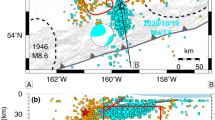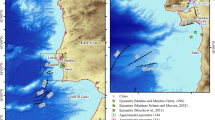Abstract
While most aspects of subduction have been extensively studied, the process of subduction initiation lacks an observational foundation. The Macquarie Ridge complex (MRC) forms the Pacific-Australia plate boundary between New Zealand to the north and the Pacific-Australia-Antarctica triple junction to the south. The MRC consists of alternating troughs and rises and is characterized by a transitional tectonic environment in which subduction initiation presently occurs. There is a high seismicity level with 15 large earthquakes (M>7) in this century. Our seismological investigation is centered on the largest event since 1943: the 25 MAY 1981 earthquake. Love, Rayleigh, andP waves are inverted to find: a faulting geometry of right-lateral strike-slip along the local trend of the Macquarie Ridge (N30°E); a seismic moment of 5×1027 dyn cm (M w=7.7) a double event rupture process with a fault length of less than 100km to the southwest of the epicenter and a fault depth of less than 20km. Three smaller thrust earthquakes occurred previous to the 1981 event along the 1981 rupture zone; their shallow-dipping thrust planes are virtually adjacent to the 1981 vertical fault plane. Oblique convergence in this region is thus accommodated by a dual rupture mode of several small thrust events and a large strike-slip event. Our study of other large MRC earthquakes, plus those of other investigators, produces focal mechanisms for 15 earthquakes distributed along the entire MRC; thrust and right-lateral strike-slip events are scattered throughout the MRC. Thus, all of the MRC is characterized by oblique convergence and the dual rupture mode. The “true” best-fit rotation pole for the Pacific-Australia motion is close to the Minster & Jordan RM2 pole for the Pacific-India motion. Southward migration of the rotation pole has caused the recent transition to oblique convergence in the northern MRC. We propose a subduction initiation process that is akin to crack propagation; the 1981 earthquake rupture area is identified as the “crack-tip” region that separates a disconnected mosaic of small thrust faults to the south from a horizontally continuous thrust interface to the north along the Puysegur trench. A different mechanism of subduction initiation occurs in the southernmost Hjort trench region at the triple junction. newly created oceanic lithosphere has been subducted just to the north of the triple junction. The entire MRC is a “soft” plate boundary that must accommodate the plate motion mismatch between two major spreading centers (Antarctica-Australia and Pacific-Antarctica). The persistence of spreading motion at the two major spreading centers and the consequent evolution of the three-plate system cause the present-day oblique convergence and subduction initiation in the Macquarie Ridge complex.
Similar content being viewed by others
References
Banghar, A. R. andSykes, L. R. (1969),Focal mechanisms of eathquakes in the Indian Ocean and adjacent regions, J. Geophys. Res.74, 632–649.
Beck, S. L. andRuff, L. J. (1984),The rupture process of the great 1979 Colombia earthquake: Evidence for the asperity model, J. Geophys. Res.89, 9281–9291.
Beck, S. L. andFuff, L. J. (1985),The rupture process of the 1976 Mindanao earthquake, J. Geophys. Res.90, 6773–6782.
Beck, S. L. andRuff, L. J. (1987),Rupture process of the great 1963 Kurile Islands earthquake sequence: Asperity interaction and multiple event rupture, J. Geophys. Res.92, 14, 123, 138.
Ben_Menahem, A. (1961),Radiation of seismic surface waves from finite moving sources, Bull. Seism. Soc. Am.51, 401–435.
Christensen, D. H. andRuff, L. J. (1985),Analysis of the trade-off between hypocentral depth and source time function, Bull. Seism. Soc. Am.75, 1637–1656.
Dewey, J. W. andSpence, W. (1979),Seismic gaps and source zones of recent large earthquakes in coastal Peru, PAGEOPH117, 1148–1171.
Dziewonski, A. M., Chou, T., andWoodhouse, J. H. (1981),Determination of earthquake source parameters from waveform data for studies of global and regional seismicity, J. Geophys. Res.88, 2825–2852.
Dziewonski, A. M. andWoodhouse, J. H. (1983),An experiment in systematic study of global seismicity: CMT solutions for 201 moderate and large earthquakes of 1981, J. Geophys. Res.88, 3247–3271.
Gutenberg, B. andRichter, C. F.,Seismicity of the Earth (Princeton University Press, 1949).
Johnson, T. andMolnar, P. (1972),Focal mechanisms and plate tectonics of the southwest Pacific, J. Geophys. Res.77, 5000–5033.
Kanamori, H. (1971),Focal mechanism of the Tokachi-Oki earthquake of May 16, 1968: Contortion of the lithosphere at a junction of two trenches, Tectonophysics12, 1–13.
Kanamori, H. (1977),The energy release in great earthquakes, J. Geophys. Res.82, 2981–2987.
Kanamori, H. andAnderson, D. L. (1975),Theoretical basis of some empirical relations in seismology, Bull. Seism. Soc. Am.65, 1073–1095.
Kanamori, H. andGiven, J. W. (1981),Use of long-period surface waves for rapid determination of earthquake source parameters, Phys. Earth Planet. Int.27, 8–31.
Kanamori, H. andMcNally, K. (1982),Variable rupture mode of the subduction zone along the Ecuador-Colombia coast, Bull. Seism. Soc. Am.72, 1241–1253.
Kanamori, H. andStewart, G. S. (1978),Seismological aspects of the Guatemala earthquake of February 4, 1976, J. Geophys. Res.83, 3427–3434.
Lynnes, C. S. andRuff, L. J. (1985),Source process and tectonic implications of the great 1975 North Atlantic earthquake, Geophys. J. R. Astr. Soc.82, 497–510.
Macelwane, J. B. (1930),The south Pacific earthquake of June 26, 1924, Beitr. Geophys.28, 165–227.
Mammericks, J., Smith, S. M., Taylor, I. L., andChase, T. E. (1975),Topography of the South Pacific, (Scripps Institute of Oceanography, La Jolla, CA).
Minster, J. B. andJordan, T. E. (1978),Present-day plate motions, J. Geophys. Res.83, 5331–5354.
Molnar, P., Atwater, T., Mammericks, J. andSmith, S. M. (1975),Magnetic anomalies, bathymetry, and the tectonic evolution of the south Pacific since the late Cretaceous, Geophys. J. R. Astr. Soc.40, 383–420.
Page, R. (1973),The Sitka, Alaska earthquake of 1972: An expected visitor, Earthquake Information Bull.5, 4–9.
Plafker, G. (1976),Tectonic aspects of the Guatemala earthquake of 4 February 1976, Science193, 1201–1208.
Purcaru, G. andBerckhemer, H. (1982),Quantitative relations of seismic source parameters and a classification of earthquakes, Tectonophysics84, 57–128.
Ruff, L. J. (1983),Fault asperities inferred from seismic body waves, InEarthquakes: Observation, Theory, and Interpretation (ed. Kanamori, H. and Boschi, E.) (North-Holland, Amsterdam) pp. 251–276.
Ruff, L. andCazenave, A. (1985),SEASAT geoid anomalies and the Macquarie Ridge complex, Phys. Earth Planet. Int.38, 59–69.
Ruff, L. andKanamori, H. (1983),The rupture process and asperity distribution of three great earthquakes from long-period diffracted P-waves, Phys. Earth Planet. Int.31, 202–230.
Schell, M. M. andRuff, L. J. (1988),Rupture of a seismic gap in southeastern Alaska: The 1972 Sitka earthquake (M s 7.6), Phys. Earth Planet. Int., in press.
Scholz, C. H., Rynn, T. M., Weed, R. W., andFrohlich, C. (1973),Detailed seismicity of the Alpine fault zone and Fiordland region, New Zealand, Geol. Soc. Am. Bull.84, 3297–3316.
Schwartz, S. Y. andRuff, L. J. (1985),The 1968 Tokachi-Oki and the 1969 Kurile Islands earthquakes: Variability in the rupture process, J. Geophys. Res.90, 8613–8626.
Stein, S. andOkal, E. A. (1978),Seismicity and tectonics of the Ninetyeast Ridge area: Evidence for internal deformation of the Indian plate, J. Geophys. Res.83, 2233–2245.
Sykes, L. R. (1967),Mechanisms of earthquakes and nature of faulting on the midocean ridges, J. Geophys. Res.72, 2131–2153.
Walcott, R. I. (1978),Present tectonics and late Cenozoic evolution of New Zealand, Geophys. J. R. Astr. Soc.52, 137–164.
Ward, S. (1979),Ringing P waves and submarine faulting, J. Geophys. Res.84, 3057–3062.
Wiens, D. A., DeMets, C., Gordon, R., Stein, S., Argus, D., Engeln, J., Lundgren, P., Quible, D., Stein, C., Weinstein, S., andWoods, D. (1985),A diffuse plate boundary model for Indian Ocean tectonics, Geophys. Res. Lett.12, 429–432.
Weissel, J. K., Hayes, D. E., andHerron, E. M. (1977),Plate tectonics synthesis: The displacements between Australia, New Zealand, and Antarctica since the late Cretaceous, Marine Geol.25, 231–277.
Wu, F. T. andKanamori, H. (1973),Source mechanism of February 4, 1965, Rat Island earthquake, J. Geophys. Res.78, 6082–6092.
Author information
Authors and Affiliations
Rights and permissions
About this article
Cite this article
Ruff, L.J., Given, J.W., Sanders, C.O. et al. Large earthquakes in the macquarie ridge complex: Transitional tectonics and subduction initiation. PAGEOPH 129, 71–129 (1989). https://doi.org/10.1007/BF00874625
Received:
Revised:
Accepted:
Issue Date:
DOI: https://doi.org/10.1007/BF00874625




